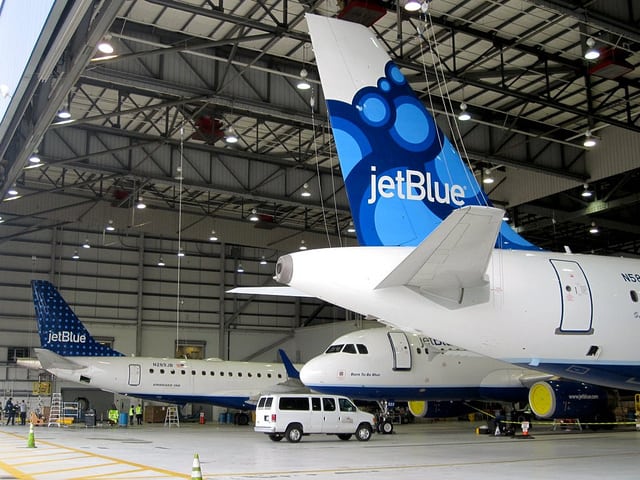[Avionics Today 02-09-2016] JetBlue has announced plans to pursue a redesign on its A320 cabins, complete with 10-inch, high-definition seatback In-Flight Entertainment (IFE) screens, satellite-based streaming video and, most importantly, free gate-to-gate Internet connectivity for passengers. The U.S.-based airline hasn’t upgraded the cabin technology on its fleet since the first flight in 2000, and is currently introducing the new connectivity features of the Fly-Fi service across all 130 of its A320s that can cater to the proliferation of Personal Electronic Devices (PEDs) and take advantage of loosened federal regulations.
 |
| JetBlue is ramping up its free Fly-Fi offering on its A320 fleet. Photo: JetBlue Airways |
“Travel preferences have changed in the last 15 years, and we are investing in what customers want today. Gate-to-gate connectivity provides customers seamless Wi-Fi and entertainment options with a full experience from takeoff to landing on their personal devices,” Jamie Perry, vice president of brand and product development, told Avionics Magazine.
JetBlue originally designed its Wi-Fi offering just before passengers could use their PEDs on the ground in airplane mode, but as In-Flight Connectivity (IFC) technology is evolving, the FAA has adjusted laws surrounding Wi-Fi connections that originally stated connections could only be established once an aircraft was above 10,000 feet. “With the regulatory shift allowing gate-to-gate use of electronics, we just need to make some changes to the software to enable connectivity on the ground. Building on our aim of delivering an experience similar to what our customers experience in their own homes, that includes connectivity,” Perry added.
Equipping with satellite connectivity was central to providing gate-to-gate connectivity, according to Don Buchman, vice president and general manager of commercial mobility at ViaSat, who provides the Fly Fi satellite connectivity service to JetBlue. Buchman noted that connectivity solutions such as Air to Ground (ATG) “are not suited to provide gate-to-gate services.”
“The ViaSat satellite-based system was designed to support service both on the ground and throughout the flight, but airlines were previously limited to in-air service above 10,000 feet by Federal regulations,” explained Buchman. “Now that those regulations have been removed, some of ViaSat’s airline customers are able to provide its Wi-Fi service gate-to-gate.”
The low cost carrier’s current offering claims to deliver between 12 and 20 Mbps for every device and can stream movies — including those from Amazon Prime through a recent agreement — through its IFE platform. The airline offers Wi-Fi on more than 60 percent of its fleet, according to Routehappy’s 2016 report on the Global State of In-Flight Wi-Fi. JetBlue will look to revamp its offering on its A320 fleet as the “re-styling” begins in early 2017 with completion targeted for 2019. Each aircraft is likely to take a total of five to seven days to upgrade.
“We’ll have a fully connected seat with gate-to-gate Fly-Fi and a connected seatback TV,” said Perry. “JetBlue will become the first U.S. airline to launch an in-flight entertainment system that connects seatback television to the aircraft’s Wi-Fi Internet connection for customer use. Customers will be able to pair their mobile device (iPhone, Android, etc.) to the seatback opening possibilities including in-flight gaming.”
The airline will be only the second U.S. airline to introduce gate-to-gate Wi-Fi capabilities after Southwest, which currently boasts a connection that is available for passengers during taxi, takeoff and landing. JetBlue has been looking to offer gate-to-gate connectivity for some time in order to adapt to growing connectivity needs and worked alongside ViaSat and Thales, which provides the connectivity and streaming TV hardware, to overcome significant challenges with the service.
Thales also worked to overcome significant technical challenges to existing systems in order to introduce the new capabilities, and provide a “homelike” Wi-Fi experience to passengers on aircraft for connectivity and streaming TV services. To surmount previous issues, the company worked to develop “a multiband, low-weight, low-drag radome that met or exceeded the latest certification requirements that could be easily tailored to virtually every aircraft type; this included certification of a new advanced composite material,” Glenn Latta, president of connectivity and TV at Thales InFlyt Experience, told Avionics Magazine. He noted that Thales also had to find a way to design and integrate ground and aircraft system software in a configurable platform, allowing airlines to customize their passenger experience, and successfully integrating with the ever-growing proliferation of PEDs and operating systems.
While Latta noted that the company has achieved the Wi-Fi capabilities it had set out originally, Thales will continue to look to improve connectivity for JetBlue. This includes introducing more operational connectivity platforms for pilots across the airline, alongside the Electronic Flight Bags (EFBs) introduced in 2013 to provide real-time weather and flight documents. The company also recently introduced Near Field Communication (NFC)-enabled cases and distributed these to its 3,500 in-flight crewmembers.
Future upgrades will also look to target an extremely individualized experience for flying passengers.
“In conjunction with the Thales Ground System, the onboard experience will be personalized down to the individual user level,” said Latta. “From targeted advertisements, recommendations and deals, and individual itineraries, the next generation experience will become completely personalized and customized based on individual user preferences and profiles. JetBlue will be able to reach out to their most valued asset (the passenger) during air travel in ways that are done today on ground based networks and systems.”